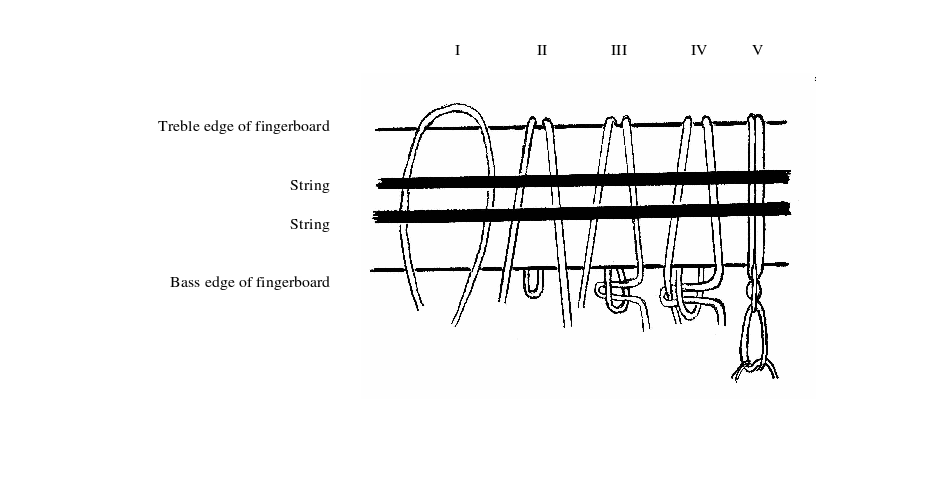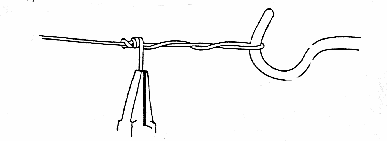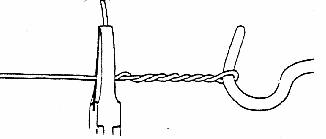
Northern Renaissance Instruments
6 Needham Avenue, Chorlton-cum-Hardy, Manchester M21 8AA
phone & fax: +44 (0) 161 881 8134 ; proprietor: Dr. Ephraim Segerman (USA)
e-mail: post@nrinst.co.uk ; on internet: http//www.nrinst.co.uk
GENERAL STRING PRICE LIST
2009
Metal Wire and Twisted Wire Strings
We sell wire for strings in 5-metre coils. Instructions on how to make a loop on the end are given further down this file. Pairs of strings on many early citterns had no loops, the same piece of wire going from one tuning peg down to the tail pin or rod, and then back to the other peg. Other instruments require loops on one end (English guitars with screw mechanisms require one for each end). We will make loops, but often need specifications of loop diameter and string length.
The original phosphorus iron (or steel) string material used in early times is not now made commercially, so we recommend German steel for the high-strength requirement of first courses on orpharions and small English citterns, and Rose iron for best iron sound on other instruments. We recommend Rose brass for strength and sound when brass is required. We try to keep stocks of these in the ranges we regularly get requests for.
Twisted brass strings with two-strand rope construction were used from the 16th to the 19th centuries for the middle and low ranges of many metal-strung instruments. We stock them in 120 cm lengths with a small (2 mm) loop in low, medium and high twist. The prices are:

Metal Wound on Metal, Metal Wound on Silk and Polymer Strings
We wind round wire of copper, silver-plated copper and silver on a metal, gut and silk cores. We do not stock or make strings of metal wound on nylon floss which are usually used for the low strings on lutes and guitars. Nevertheless, we do make high-twist and roped (catline) strings out of nylon and other polymer monofilament for experimentalists Until a market for such strings develops, we stock only a few diameters of each type of polymer. These sound richer than plain monofilament in the treble, and roped nylon sounds very much like gut catlines in the bass. Prices depend on diameter and length.
Second Quality Strings
Second Quality strings are half the price of First Quality strings. They have the same guarantee about breaking when first tuned up. We cannot guarantee having Second Quality of the requested diameter or ED in stock, and request instruction indicating whether one wants the order canceled or filled with a First Quality string when it is not in stock. We cannot reserve Second Quality strings for customers or hold over an order until they are generated.
Fret Gut, Tail Gut and String Treatments
The price of Fret Gut or Tail Gut in pounds (£) per half-metre is on the bottom of the following page. Best treatment is a coating, either a modern chemical or the traditional linseed oil, that makes strings more stable and durable. Varnishing is an alternative. Polishing catlines is for those who prefer a smooth surface.
ORDERING and PAYMENT
Strings may be ordered individually or in sets; you may wish to choose the specification yourself, or you can leave this choice to us. Further information on discounts, payment etc. will be found on our Strings Order Form. Note that prices here do not include postage and packing. We are very experienced with stringing all types of early instruments, and can pick the appropriate strings which will suit your instrument and playing style, and your pocket. If your instrument’s strings are being a problem, or if you want to experiment and improve the stringing, we will be glad to work with you to sort it out. We have no set weekday business hours; we are here at most reasonable times. Orders are usually sent out within one or two days if the strings are in stock and the customer has a record of quick payment. If a wound-on-gut string is not in stock, we will need 10 days to stretch the core for winding. Please let us have your phone number and/or your e-mail address; this will help in case there is any query over your order.
COMPLAINTS and RETURNING STRINGS
If you have a complaint about a string, please tell us, or ask the shop you brought it from to do so. Return the string, with its original packet if possible so that we can try to trace the trouble. We will test the string, and if we can ascertain that it was faulty we will replace it at no charge. If mistreatment is evident we will send advice. If the evidence is inconclusive we will allow 50% off the price of a replacement. Whatever the complaint, we do want to know about it, since this can help us to maintain our high standards.
Any unwanted strings which are unused and undamaged may be returned within a month. With most types of strings we will credit your account immediately. (If your strings were specially made for an unusual specification, we will credit your account when we are able to find another customer for them.) Please be sure to pack strings well, with plenty of padding, otherwise we may have to downgrade them before resale, and thus reduce your credit.
Diameter Conversion Table

mm
= millimetres; thou = 1/1000 inch; grad = grads of millimeters, a
19th century measuring scale where 20 grads = 1 mm.
(Called ‘PM’ by Pirastro). The number of grads is about half
that in thou.
Handy tip: use a tape measure marked in both inches and cm. Converting mm to thou is just like cm to inches on the tape
SHORT ALL-GUT STRINGS
2009 PRICES

FRET
OR TAIL GUT Price per half-metre

MEDIUM ALL-GUT STRINGS
2009 PRICES

LONG ALL-GUT STRINGS
2009 PRICES

Tying Frets

Feed a loop between the strings and the fingerboard (I), then around the back of the neck and back to the original side (II). Form a second loop and feed it through the first loop (III), and feed the free end through the second loop (IV). Pull tight (parallel with the neck). Compact the knot by first distorting it with pulling harder on one side than on the other and then reversing sides, and finally pulling it symmetric. Stretch the gut further by sliding the fret to the right (where the neck is thicker). Then slide it back again and re-tighten the knot. Repeat the last two steps until the fret is tight enough. Then tie another knot to lock it (V), tighten it, and trim the loose ends. Some prefer the greater neatness of replacing the second knot by swollen burned ends (first trimming the ends so that about 3 mm sticks out, and heat with a flame or hot soldering iron until the swelling touches the knot).
Making End Loops on Metal Strings
Find a metal hook with diameter greater than the pin or head of the peg over which the final loop must go on the instrument. Fix that hook into the end of a handle. Cramp the wire between leather pads about 2 metres from the hook (around which it is looped), with the other end held by pliers. Turn the hook to make 4 loose turns (the following illustration shows fewer turns).

Let go with the pliers and reverse 4 turns to relieve the twist in the string.

Make a few close turns over the first loose windings.

Gently hold the close turns and the end of the wire with the pliers, and turn until the wire is twisted evenly together.

Malcolm Rose
Tail Fixing and Making End Loops on Gut Strings
Thicker plain gut strings can usually be secured by a simple knot underneath the tailpiece if the knot is considerably bigger than the hole (or the slot extending from the hole) that holds it. This is shown here:

Wound strings come with a knot and a loop. They can be fixed to the tailpiece using the knot in the same way, but they can also be fixed using the loop, as shown here:

Thinner plain gut strings can be fixed by tying knots on top of knots to get the lump on the end thick enough, but it is easier and safer to make a loop to tie to the tailpiece.
 To
make a loop at the end of a string, first tie a knot or burn a lump
with a candle (or lighter flame or the tip of a soldering iron) at
the very end. Tie another knot about 15 mm from the first for a
violin, viola, or treble viol, and about 25 mm from the first knot
for a cello or bass viol. Pass the knotted (or burned) end through
the second knot while it is still loose, and tighten the knot enough
so that the end will not pull through. This stage is shown here:
To
make a loop at the end of a string, first tie a knot or burn a lump
with a candle (or lighter flame or the tip of a soldering iron) at
the very end. Tie another knot about 15 mm from the first for a
violin, viola, or treble viol, and about 25 mm from the first knot
for a cello or bass viol. Pass the knotted (or burned) end through
the second knot while it is still loose, and tighten the knot enough
so that the end will not pull through. This stage is shown here:
Then stick a round object in the loop and pull tight.
If one has made the loop before thinking about attachment to the tailpiece, or if one has a wound string with loop provided, one has to thread the other end of the string through the tailpiece hole from the underside before putting it through the loop. Finding the hole to stick the end in can require several attempts because usually it can’t be seen. Bending a kink near the end can help. The threading-through needs to be done carefully because any kink created on the string can ruin it. With plain gut strings, one can avoid this nuisance by sticking the end in the hole from the topside of the tailpiece at the beginning, and making the loop with the string in the tailpiece hole. The fixing of the string is completed by threading the other end of the string through the loop and pulling tight.
Strings often break because there are edges on the tailpiece that force the string to bend very sharply over them. Check for these, and if there are such sharp edges, round off every edge that the string bends over.
QUANTITY DISCOUNTS
Quantity discount on strings applies to the total of the current order [before subtracting pre-payment discount and adding postage & packing and bank charges]. These are, for orders over:
£200-5%, £250-10%, £300-15%, £350-20%, £400-25%, £450-30%, £500-35%.
Orders purchased over a 12 month period totalling the following amounts will receive discounts of:. £400-5%, £500-10%, £600-15%, £700-20%, £800-25%, £900-30%, £1000-35%
PRE-PAYMENT DISCOUNT of 5% - not for purchases by credit or debit card
A 5% discount on the value of the strings (after quantity discount, if applicable) is given to customers who pay before the strings are dispatched. Ways to do this are as follows:-
1) Your account is in credit to the value of your new order, so pre-payment discount is automatic.
2) Ask for a pro-forma invoice and send the amount indicated when it is received.
3) Either enclose a cheque for the correct amount with your order, or if you are not quite sure of prices then please mark your cheque with the words ‘Not to exceed £.....’, and we will fill in the exact amount.
New customers are expected to pay in advance before an order is sent, and get the 5% pre-payment discount (except if payment is by Credit or Debit cards).
POST AND PACKING CHARGES

Strings are sent by First Class mail in the U.K. and Airmail abroad. The above post and packing rates are a good guide to the postal and insurance charges. Orders which involve us sending a large parcel or 2 or more parcels may require extra postage. Please advise us if you wish to be informed of this before your order is dispatched. The U.K. Post Office advises us to send items to some countries by 'International Signed For' as routine. This cost is added to relevant invoices.
WAYS TO PAY
We accept Visa and Mastercard credit and debit cards and Maestro and Solo debit cards. The 5% prepayment discount does not apply. For security, the card information should be given to us by phone, fax or post.
We can accept cheques, money orders or bank drafts only if they are in £ (pounds) Sterling that go through a U.K. bank.
Payment can also be made directly to our NRI account at the HSBC bank at 577 Wilbraham Rd., Chorlton-cum-Hardy, Manchester M21 1AH, U.K.; sort code: 40-31-17, Swift code: MIDLGB22; BIC: MIDLGB2144P, IBAN: GB34MIDL40311781389955.
Northern Renaissance Instruments
6 Needham Avenue, Chorlton-cum-Hardy, Manchester M21 8AA, U.K.
Phone & Fax: +44 (0) 161 881 8134 ; proprietor: Dr. Ephraim Segerman [USA]
e-mail: post@nrinst.co.uk ; on internet: http://www.nrinst.co.uk
STRINGS ORDER FORM
